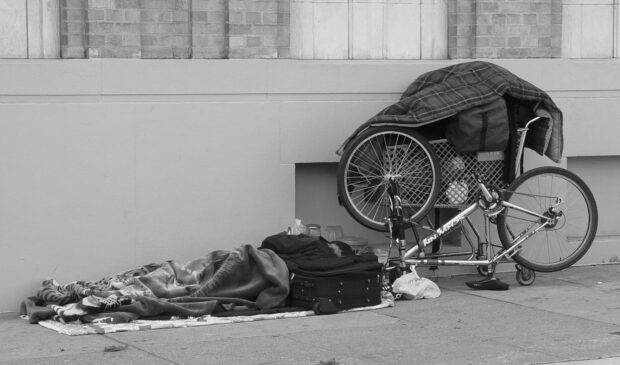Annual count shows small drop in Austin’s homeless population
Thursday, May 25, 2023 by
Chad Swiatecki Data from the city’s first point-in-time count of the local homeless population in three years show a slight decrease in the total number of people living without shelter, with laws against camping in public causing a sharp decrease in the number of unhoused people in the downtown core.
Austin’s Ending Community Homelessness Coalition (ECHO) released data from the 2023 count on Wednesday morning during a panel discussion held with Urban Land Institute Austin, with local developers and real estate professionals on hand to discuss the role that a tight housing supply and high cost of living plays in people losing their homes.
There were 2,374 people without homes on the night of the 2023 count in late January, with 1,108 people using temporary shelters and 1,266 unsheltered and living in encampments or hidden away in parks and greenbelts. In 2020, the last count conducted prior to the Covid-19 pandemic, there were 2,506 total people unhoused, with 932 in shelters and 1,574 with no shelter at all.
The count took place in 74 geographic regions across all 10 City Council districts, with District 5 showing the greatest increase – 135 percent since 2020 (60 people in 2020 versus 141 in 2023). District 6 had the next highest increase, up 95.7 percent since 2020 (23 people in 2020 versus 45 in 2023).
District 3 had the largest downward change, with a 38.3 percent decline from the 2020 count (282 people in 2020 versus 174 in 2023). District 9, which encompasses most of the downtown area, had a drop of 35.2 percent since 2020 (600 people in 2020 versus 389 in 2023) but still had the area’s largest number of people experiencing homelessness.
Adding to those numbers, the Travis County Sheriff’s Department reported there were 699 people “likely to be experiencing homelessness” on the night of the count.
Matt Mollica, ECHO’s executive director, noted the one-night count misses the people who have just found homes and may be in unstable situations, or those about to lose their homes. He said monthly data from local shelters suggests there are around 4,600 people without a home in the Austin area, with that number almost certainly impacted by the growth of neighboring suburbs that is driving up housing costs in those communities as well.
“One of the things that’s really important to recognize about Austin is just how difficult a rental market we’re in for folks who are even middle income since I think the 80 percent median family income is like $80,000 a year or something like that, or even higher. We live in a community that just has really high cost of living and that’s driving our rates of homelessness up,” he said. “You look at a city like Detroit, it has much lower rates of homelessness than Austin does but much higher rates of poverty, so they have folks who are living with much less money but still have access to housing because there are more naturally affordable housing units there.”
Panelists discussed the drive to create affordable units specifically set aside to place the recently homeless throughout the city, with roughly 1,000 of those homes scheduled for completion soon. One of those is Cady Lofts, a 100-unit apartment complex in the Hancock neighborhood from SGI Ventures that had to assemble funding from seven capital sources, including housing vouchers and affordable housing bonds, to make the project financially feasible.
Sally Gaskin, president of SGI Ventures, said developers must have a plan to involve the surrounding community to build support for new housing projects intended to serve the formerly homeless.
“There were a lot of questions, very understandably. We met with the neighborhood on many occasions during the application process and they were initially not very supportive, but in the end came around. The best way to describe it is that they took a very neutral position,” she said. “Many of the neighbors that I’ve heard from are actually very excited because they are very aware of the issue. We’re hoping that we’re going to be able to house a lot of the people that have been homeless in that immediate neighborhood so that they’re able to stay kind of in their neighborhood and thrive with services and with permanent, stable housing.”
While some efforts to assist the homeless have met with loud approval – including the Community First! Village tiny homes project that just recently received eligibility to accept federal housing vouchers – there was caution against using the homeless as test cases or experimental populations for new types of housing that haven’t been widely tested in the market.
“We love new ideas. We love new materials, and we love new models … we get calls all the time, ‘I have this great idea about used airplanes,’ or you name it, we hear it,” said Dianna Grey, homeless strategy officer for Austin. “We just have to be really careful about that sort of experimentation for a tenant population that can least afford to have it go wrong and an owner and operator that can least afford to have it go wrong.”
Photo made available through a Creative Commons license.
The Austin Monitor’s work is made possible by donations from the community. Though our reporting covers donors from time to time, we are careful to keep business and editorial efforts separate while maintaining transparency. A complete list of donors is available here, and our code of ethics is explained here.
You're a community leader
And we’re honored you look to us for serious, in-depth news. You know a strong community needs local and dedicated watchdog reporting. We’re here for you and that won’t change. Now will you take the powerful next step and support our nonprofit news organization?











